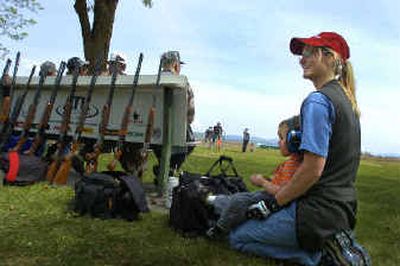Trapshooting competition draws crowds

Hundreds of trapshooters set their sights sky high at the Inland Empire Handicap, a tournament this weekend at the Spokane Gun Club in Greenacres.
Clay targets moved through the air like orange neon Frisbees on Saturday as men, women and juniors attempted to shatter each in midair with a single shotgun blast.
The event, hosted by The Inland Empire Trapshooting Association, attracted an estimated 450 competitors who came from throughout the Northwest and Canada to compete.
Mother Nature cooperated, and targets glided through a pale blue sky as the pop of ammunition sounded and the faint scent of gunpowder filled the air.
Bill Elliott, a member of the Rockford Gun Club who helped organize the event, said weather often adds a wild card. When gusts are high, he likened shooting to a mutant form of ultra-extreme golf.
“This is an incredible sport. It’s like doing 100 putts from 100 different directions. If you add the weather to it, it’s like putting on a jet boat racing across Coeur d’Alene Lake on a windy day.”
Elliott said the shoot has been hosted by area gun clubs since 1916 and has grown into the second largest event of its type in the Northwest. Additionally, he said, it’s the “richest trapshoot west of the Mississippi,” with more than $43,500 in money, trophies and buckles with embedded gold coins awaiting lucky winners, who had 525 opportunities to nab a piece of the action.
Participants increased their money-making odds with an auction where competitors bid on other shooters, buying a piece of their potential success. High-end shooters fetched as much as $600 and low-ends as little as $25. High-ends and low-ends were paired up, and teams and winners and their bidders divided the auction’s take.
“This is a betting crowd, so we buy each shooter,” said Dan Daniels of Florence, Mont., who said guns sell for as much as $250,000.
Shooters were grouped in squads of five. Each shooter took five shots at each of five positions, called “posts,” for a total of 25 shots. Those 25 shots constitute a “round.”
Competitors shot four rounds at four different stations or “traps” for a total of 100 shots.
Interest in the sport has increased in the last few years, Elliott said, because more juniors and women are competing. “If you take 500 shooters and 50 of them are juniors – that’s fantastic. We’ve sent kids to the Olympics who have come through this event.”
Dick Dauenhauer of Spokane has a 23-year-old son, Seth, who graduated from trapshoots to vying for a spot on a U.S. marksmanship team. He’s currently training at the Olympic Training Center in Colorado Springs, Colo. “That’s what many of these kids are trying for.”
Targets for Olympic shoots travel about 90 miles per hour, which is more than twice the 42-miles-per-hour speed of regular trapshooting, Dauenhauer said.
Kristy Hines, a 17-year-old home-school student who lives in the West Plains, started shooting with her older brother when she was 12 years old. She competes in a dozen large and small competitions annually and hopes to someday join the Ladies’ All American Team.
“I like the individual competition. It doesn’t matter what any judge thinks, it’s just how many targets you break,” Hines said.
Standings, which are averages of the number of targets shooters hit during rounds of 100, determine handicaps. Handicaps decide how close participants stand from where the clay targets are released. Juniors start from 19 yards away and adults move forward or backward to a maximum of 27 yards.
Jeff Betz, an 18-year-old from Cheney, plans on hitting at least 98 of every 100 targets when he competes. He believes the sport is 90 percent mental and explains that winning involves “keeping a positive mindset at all times and remembering that the only person who can beat you is yourself.”
Daniels admits that he’s enamored with the sport. “I can talk about this game for hours, the attributes and the people.”